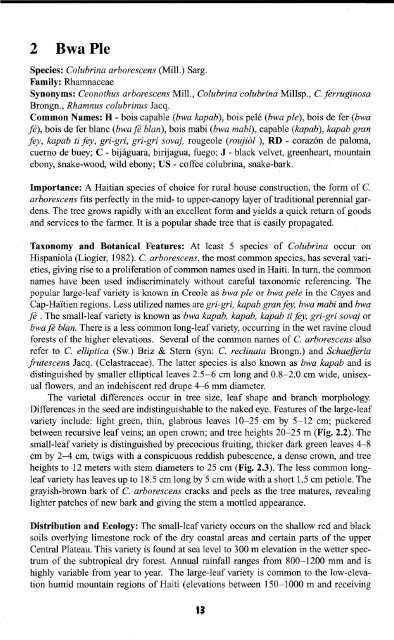Important Trees of Haiti
Important Trees of Haiti
Important Trees of Haiti
You also want an ePaper? Increase the reach of your titles
YUMPU automatically turns print PDFs into web optimized ePapers that Google loves.
2 Bwa PIe<br />
Species: Colubrina arborescens (Mill.) Sarg.<br />
Family: Rhamnaceae<br />
Synonyms: Ceonothus arborescens Mill., Colubrina colubrina Millsp., C. ferruginosa<br />
Brongn., Rhamnus colubrinus Jacq.<br />
Common Names: H - bois capable (bwa kapab), bois pele (bwa ple), bois de fer (bwa<br />
fe), bois de fer blanc (bwa fe blan), bois mabi (bwa mabi), capable (kapab), kapab gran<br />
fey, kapab ti fey, gri-gri, gri-gri sovaj, rougeole (roujiol ), RD - corazon de paloma,<br />
cuerno de buey; C - bijaguara, birijagua, fuego; J - black velvet, greenheart, mountain<br />
ebony, snake-wood, wild ebony; US - c<strong>of</strong>fee colubrina, snake-bark.<br />
Importance: A <strong>Haiti</strong>an species <strong>of</strong> choice for rural house construction, the form <strong>of</strong> C.<br />
arborescens fits perfectly in the mid- to upper-canopy layer <strong>of</strong>traditional perennial gardens.<br />
The tree grows rapidly with an excellent form and yields a quick return <strong>of</strong> goods<br />
and services to the farmer. It is a popular shade tree that is easily propagated.<br />
Taxonomy and Botanical Features: At least 5 species <strong>of</strong> Colubrina occur on'<br />
Hispaniola (Liogier, 1982). C. arborescens, the most common species, has several varieties,<br />
giving rise to a proliferation <strong>of</strong>common names used in <strong>Haiti</strong>. In tum, the common<br />
names have been used indiscriminately without careful taxonomic referencing. The<br />
popular large-leaf variety is known in Creole as bwa pte or bwa pete in the Cayes and<br />
Cap-HaYtien regions. Less utilized names are gri-gri, kapab granfey, bwa mabi and bwa<br />
fe . The small-leaf variety is known as bwa kapab, kapab, kapab ti fey, gri-gri sovaj or<br />
bwa fe blan. There is a less common long-leaf variety, occurring in the wet ravine cloud<br />
forests <strong>of</strong> the higher elevations. Several <strong>of</strong> the common names <strong>of</strong> C. arborescens also<br />
refer to C. elliptica (Sw.) Briz & Stern (syn: C. reclinata Brongn.) and Schaefferia<br />
frutescens Jacq. (Celastraceae). The latter species is also known as bwa kapab and is<br />
distinguished by smaller elliptical leaves 2.5-6 cm long and 0.8-2.0 cm wide, unisex-ual<br />
flowers, and an indehiscent red drupe 4-6 mm diameter.<br />
The varietal differences occur in tree size, leaf shape and branch. morphology.<br />
Differences in the seed are indistinguishable to the naked eye. Features <strong>of</strong>the large-leaf<br />
variety include: light green, thin, glabrous leaves 10-25 cm by 5-12 cm; puckered<br />
between recursive leaf veins; an open crown; and tree heights 20-25 m (Fig. 2.2). The<br />
small-leaf variety is distinguished by precocious fruiting, thicker dark green leaves 4-8<br />
cm by 2-4cm, twigs with a conspicuous reddish pubescence, a dense crown, and tree<br />
heights to 12 meters with stem diameters to 25 cm (Fig. 2.3). The less common longleafvariety<br />
has leaves up to 18.5 cm long by 5 cm wide with a short 1.5 cm petiole. The<br />
grayish-brown bark <strong>of</strong> C. arborescens cracks and peels as the tree matures, revealing<br />
lighter patches <strong>of</strong> new bark and giving the stem a mottled appearance.<br />
Distribution and Ecology: The small-leaf variety occurs on the shallow red and black<br />
soils overlying limestone rock <strong>of</strong> the dry coastal areas and certain parts <strong>of</strong> the upper<br />
Central Plateau. This variety is found at sea level to 300 m elevation in the wetter spectrum<br />
<strong>of</strong> the subtropical dry forest. Annual rainfall ranges from 800-1200 mm and is<br />
highly variable from year to year. The large-leaf variety is common to the low-elevation<br />
humid mountain regions <strong>of</strong> <strong>Haiti</strong> (elevations between 150-1000 m and receiving<br />
13

















